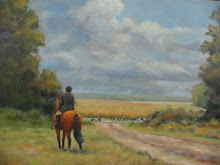It is my observation that a painter always enjoys a conflict between logic and his instincts, and with me instinct always wins - Vaughn Flannaery
 Not sure where I first saw any of his paintings, except it has only been on line, but really enjoy his style and his take on the theme of horses and racing. His paintings seem to be of the behind the scenes motifs.
Not sure where I first saw any of his paintings, except it has only been on line, but really enjoy his style and his take on the theme of horses and racing. His paintings seem to be of the behind the scenes motifs.He did advertising in the '20's and this shows in his sense of design and composition, was a director of the Maryland Jockey Club and moved to Harford County, MD from NYC in the early '30's.
I haven't been able to find the name of this panting so until I can, it Hotwalking. Could be a horse going to the sale ring, or just back to the barn. I like the color notes made along the bottom.












